

I should mention that people asked me why I was going to Finland and
Norway. The answer, plain and simple, is because I could. It is as good a
reason as any. In my usual habit of advance preparation, I read about
Finland on the plane on the way over. That is how I learned that two
Finnish brothers hold the world's record for sitting on an anthill. That
fact, it must be said, told me nothing about Finland. Anyway, we flew
through Helsinki to the Savonlinna airport, one of the smallest I have
seen. There is a single gate, and when my brother walked up to the
rent-a-car booth the rental car guy greeted him by name. We drove out of
the airport in our rented Opel (go ahead, laugh) and into the woods
outside Savonlinna, and were greeted immediately by a moose crossing sign.
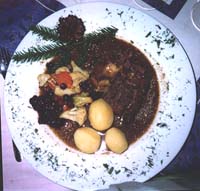 They
are everywhere, but the only moose we saw were on our plates at the
Finlandia - a bit worse for wear, but delicious. And the moose sign got
me thinking about why it is that Ann and I only vacation together in
places where there are moose. (Alaska, Maine, Finland) I have no
answer.
They
are everywhere, but the only moose we saw were on our plates at the
Finlandia - a bit worse for wear, but delicious. And the moose sign got
me thinking about why it is that Ann and I only vacation together in
places where there are moose. (Alaska, Maine, Finland) I have no
answer.
Our first impression of the resort itself was not promising - the main building was practically deserted, the store had nothing in it, and the first cabins we saw were primitive and small. Our cabin, however, is neither of those things. It has two bedrooms and a loft and a total of eight beds, two bathrooms, and its own sauna. One of the bathrooms has a marvelous view of the lake from both the toilet and the showers, which some in our party found disconcerting. The cabin also has a full range of Finnish appliances. On the plumbing front, this is an advantage. The showers set temperature and water flow separately, so that you can set a temperature and keep it. The shower head is hand-held but can also be attached to a bar that allows you to choos e the height, and the flow is at the perfect level. The toilets work correctly on a low level of water and some even have two speeds. The fireplace is also a marvel - the material of the chimney heats up and retains heat - thus continuing to heat the room long after the fire is extinguished. Of course, with Dad setting the heat to 25 celsius, this worked as a disadvantage. As did the heated bathroom floor, which ordinarily would have been my best friend. As it was, it was fortunate that we could turn it off. (Actually, it seems that the Finns heat all kinds of things - there was a heated towel rack in the hotel room that I got later).
On the electrical appliance front, things lag a bit behind. I have no complaints about the stove, the refrigerator, the microwave, or even the Bosch dishwasher. But the washer and dryer are another story. Chalk it up to our American denseness that it took us a full day to figure out what the washer was, and two full days to identify the dryer. But eventually it did dawn on us that the thing in the bathroom had to be the washer, because dryers don't have water hoses. As for the dryer, Mike had to dry a towel in it to believe. It is a big thing that looks like a freezer, with three rows of things that come out from the back almost all the way to the front. One hangs the clothes on these things and the machine blows hot air in their general directi on. It did okay with a single towel, but an entire load of clothes could take all night and they were weird and stiff when it was done. I would like to think that other ones work better, but the fact that it was possible to set the thing to run for six hours tells me that its bugs are probably features.
The beds were no party either. They were far too narrow to ever relax on, more like a cot than a bed. The sheets reduced us to giggling, as they were bags that went over the thin mattress-like things (that I suspect are actually covers). The beds also moved about the floor very easily. Sounds like a good idea, but the advantage faded in the middle of the night when you rolled into the middle of the two that you had put together to try to get a normal size bed.

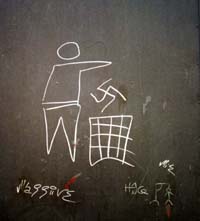 It is
not just the appliances that are different. There are plenty of other
things. One of the first, most obvious ones is crime. While I scoff at
people who let crime in the United States cramp their style, I must admit
that there is crime. Here, while I suppose there must be crime, there are
strong signs that there is not much. We simply walked through customs
without so much as a glance. Bicycles, which are everywhere, are nowhere
locked. Nowhere have I seen the barred windows or high fences of crime
areas. Or even lights. Finns even wait for walk lights. Even when there
is not a car in sight. The only sign of illegality that I have seen is
graffiti - including the red painted testicles of the statue of a ram on
the castle grounds.
It is
not just the appliances that are different. There are plenty of other
things. One of the first, most obvious ones is crime. While I scoff at
people who let crime in the United States cramp their style, I must admit
that there is crime. Here, while I suppose there must be crime, there are
strong signs that there is not much. We simply walked through customs
without so much as a glance. Bicycles, which are everywhere, are nowhere
locked. Nowhere have I seen the barred windows or high fences of crime
areas. Or even lights. Finns even wait for walk lights. Even when there
is not a car in sight. The only sign of illegality that I have seen is
graffiti - including the red painted testicles of the statue of a ram on
the castle grounds.
Would also have to say that the tort system must function very differently in Finland than in the United States. I really can't say that this makes it a worse place. But I did see a number of places where the stupid could injure themselves and no eff ort seems to have been made to stop them. For example, the elevator in the hospital had no inside door, so that the doors and walls of the other floors went by as you went up. There is simply a sign warning you not to lean against it.
The first night in the cabin Dad got up at 1 am and decided to restart the fire -an incredibly noisy enterprise. He then stumbled around looking for things in the kitchen, alternately banging cabinet doors and cursing to himself. Ann and I woke up to the first crumpling of paper and giggled helplessly at each new loud noise or curse. Then, at 1:30, he announces "I made coffee." Gales of laughter.
The next day was Sunday. Turns out that everything in Finland is closed on Sunday. We spent the day walking around watching Ann try to open closed doors. The only thing we found open was a local history museum that had a whole section devoted to cell phones - the humor of which can only be appreciated if you realize that Ann works in telecommunications. Other than that, even the churches were closed on Sunday, not to mention the police. This became more serious later when we started looking for food. Never found any and ended up eating cheese, crackers and popcorn for dinner. Although the restaurants are open late on other days, this experience, and the fact that pretty much everthing other than the restaurants closes by 5, led us to make lunch our main meal and eat a light dinner at home. This leaves us at home playing scrabble, which Ann wins one night with the word "zarf."
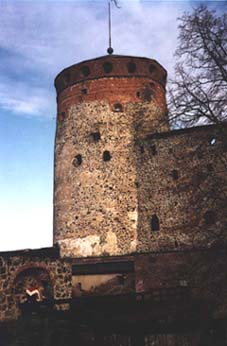 Monday we went to Savonlinna castle, which was
built in the fifteenth century. Some of the renovations had not exactly
been done with that idea in mind. For example, the tops of the turrets
were red brick. That was the Russians' fault. But there was no blaming
the Russians for the extremely modern Scandinavian furniture that filled
every room. There really was no attempt to maintain the old look. It
kind of distracted from flights of fancy. They did retain the old privies
though. They were just classic latrine seats in an area that jutted out
from the wall about 40 feet above the water. I imagine that it was not
all that comfortable in winter.
Monday we went to Savonlinna castle, which was
built in the fifteenth century. Some of the renovations had not exactly
been done with that idea in mind. For example, the tops of the turrets
were red brick. That was the Russians' fault. But there was no blaming
the Russians for the extremely modern Scandinavian furniture that filled
every room. There really was no attempt to maintain the old look. It
kind of distracted from flights of fancy. They did retain the old privies
though. They were just classic latrine seats in an area that jutted out
from the wall about 40 feet above the water. I imagine that it was not
all that comfortable in winter.
The tour was given by a merry little man who smiled constantly. However, since he spoke little or no English, the information about the castle was conveyed by a packet of papers that he gave us. The tour sheet said that the men in the castle got a ration of nine pints of beer a day during the week and twelve on Sunday. The sheet itself indicated that meant that they were sotted all of the time, which seemed like a logical conclusion at the time. However, my experience with Finnish beer leads me to conclude otherwise. First, if the beer in question was the standard Finnish beer sold commercially, it may have been punishment, not a benefit. I really didn't go there expecting anything. I had, after all, never seen a Finnish beer that I can remember in America. It turns out that there is a reason for that. I tried six bottled beers, Karhala, Karhu, Koff, Sandels, Lapin Kulta and Olvi Special, and they were uniformly bad. Most of the bottled beers were pilseners, which are admittedly not my favorites. But they really weren't good pilseners. Some were awful, and one or two distinguished themselves by the fact that one could get used to them. However, what the castle more likely served was something related to the home-made beer that they served at the traditional buffets. It was very sweet, and extremely weak, clearly intended to serve as a beverage as much or more than an intoxicant. I am relatively certain that an average man could drink nine of them without problem.
When we left the castle Dad asked the tour guide if he could recommend a restaurant in town. He said no - which would be consistent with our experience with food in Finland up to that point. But we wandered out and went to a restaurant called Majakka , which was excellent, and much more representative of Finnish cuisine than the pizza we made the mistake of eating the day before. Interestingly enough, our guide, he of no recommendations, showed up there shortly after we did. I went to Finland with dire expectations about the food. I was expecting something like German food, but with more cream sauce and the occasional indescribable pickled fish. They certainly eat plenty of meat, and cream sauces as well. But there are fresh vegetables and fruits with almost every meal and many of them better than one finds in the States. (There are potatoes with every meal too, but that is less of a benefit). I had some meals that were absolutely excellent. The salmon at Majakka stands out, as does the moose at Finlandia - despite the fact that the Finlandia shares a building with a hospital. (Looking for the Finlandia and discovering that we were trying to get into a hospital to eat was one of the grand moments of our search for food on Sunday). We also did one traditional Finnish lunch buffet - can't say that I am running back for more, but there were things on it that were quite good.
On the other hand, I just cannot say enough bad things about the pizza. Should you ever find yourself in Finland, my recommendation is to stay as far away from the pizza as possible. Pizza is everywhere, as is kebab pizza. Everywhere. The first one we had was at a Shell station on a Sunday. The ordering system was so obscure, and the clerk's english was so minimal that when Ann ordered a slice of plain pizza I decided to follow her example, as did Dad. We each got an entire pizza with olives and some indescribable form of ham. The crust was incredibly thin and the sauce was mediocre. But I have come to believe that it met Finnish pizza standards. For one thing, we found the unspeakable ham, two different brands of it, each titled "pizza ham," in the grocery store. For another thing, when Ann and I tried the kebab pizza - partly due to time constraints, partly out of intellectual curiosity - it had the same crust and virtually the same sauce. The kebab place also convinced us that the word slice just means whole pizza to the Finns, because we asked him how large the pizza would be and he called it a slice, then delivered two entire pizzas.
It was not as expensive as we expected for the most part. Restaurants are no worse than I pay at home, though they would probably be a shock for the McDonalds and Fridays crowd. Groceries are normal enough. And my hotel room on the water in Savonlinna was positively cheap. Alcohol, though, is murder, and anything stronger than beer is available only in the state-run Alko, which has very limited hours, and, of course, is not open on Sunday.
 At
some point, we checked out a thrift store in Savonlinna. It sucked. We
decided that either Finns own nothing worth having or that when they do
they keep it. It is probably the latter. It is a thrifty society. They
build solid energy-saving houses and water-saving fixtures. They
encourage recycling with a one mark (20 cent) deposit on bottles. (And
they have nifty little machines instead of inbreds to calculate the
refund). I see no signs of serious poverty, but I also see no
ostentatious displays of wealth. What glitzy stuff there is comes from
America, including much of the music and most of the toys. (And the two
things most likely to have English names are sex shops and bars).
Mini-golf seems popular, but while it is physically the sam e as in
America, it is completely without the bells and whistles (windmills and
towers) that accompany it here.
At
some point, we checked out a thrift store in Savonlinna. It sucked. We
decided that either Finns own nothing worth having or that when they do
they keep it. It is probably the latter. It is a thrifty society. They
build solid energy-saving houses and water-saving fixtures. They
encourage recycling with a one mark (20 cent) deposit on bottles. (And
they have nifty little machines instead of inbreds to calculate the
refund). I see no signs of serious poverty, but I also see no
ostentatious displays of wealth. What glitzy stuff there is comes from
America, including much of the music and most of the toys. (And the two
things most likely to have English names are sex shops and bars).
Mini-golf seems popular, but while it is physically the sam e as in
America, it is completely without the bells and whistles (windmills and
towers) that accompany it here.
So as I may have mentioned, this was the very off season. Not sure why. True it was cloudy and rained with some frequency, but never really in a way that would stop you from doing anything. It wasn't that cold and the leaves were beautiful. Well, I didn't think it was that cold - the members of the party from Florida beg to differ. But in any event, if New England can have a fall tourist season it would seem to me that the Lake lands could as well, but they don't. Anyway, being the off season did mean that some stuff was closed, but really only one thing that I cared about. And the places we did go to, we had mostly to ourselves. So, back to where we went.
We went to Lapeenranta. Lapeenranta was a fair drive away and we went there only because the Fodor's or the Frommer's or some such thing said that from Lapeenranta one could do a day trip to Vyborg, in Russia, without a visa. Turns out that only Finns could do day trips without a visa. Everyone else had to spend overnight on a boat. Pretty much out of the question even if the boats had been running. So there we are in Lapeenranta, in some of the heaviest rain of the entire trip. We go to a cool museum - one of the collection of cool stuff variety, and then an art museum. The art museum had some passable art. The rest of it was what started us ranting about bad Finnish art. There was one room with a bunch of stuff piled behind a wood construction fence, and one room with a variety of different sized sculptures of the bottom of a man's overcoat and his boots. After that there was bad art everywhere, and not much to redeem it. Not until you realize that, for the most part, Finnish art lay not in the stuff they hung in museums, but in design, in the buildings, the furniture, the silverware, even the plumbing fixtures. There is the art.
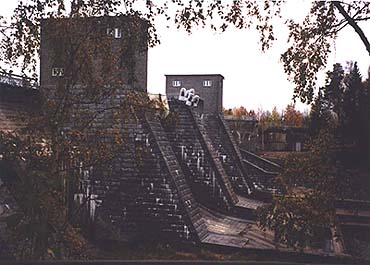 From
Lapeenranta, we went to Imatra. Imatra is less industrial than
Lapeenranta, but somewhat of a disappointment nevertheless. The tourist
guide, probably the same one that said we could go to Vyborg, said that
Imatra had a waterfall and Russian style. Turns out that the waterfall,
once an impressive set of rapids, is now water behind a dam that is
allowed to flow over, to the accompaniment of lights and music, at set
times during the tourist season. The Russian style is also there, but -
and this is true in Lapeenranta as well - it is more Soviet than Russian.
Blunt and utilitarian.
From
Lapeenranta, we went to Imatra. Imatra is less industrial than
Lapeenranta, but somewhat of a disappointment nevertheless. The tourist
guide, probably the same one that said we could go to Vyborg, said that
Imatra had a waterfall and Russian style. Turns out that the waterfall,
once an impressive set of rapids, is now water behind a dam that is
allowed to flow over, to the accompaniment of lights and music, at set
times during the tourist season. The Russian style is also there, but -
and this is true in Lapeenranta as well - it is more Soviet than Russian.
Blunt and utilitarian.
The next day we take it kind of easy, we go to a museum about wood - not so surprising when you realize that Finns have a long and deep relationship with trees in all of their forms. In fact the museum even had a display about making pine bread - that 's right - bread in which the primary ingredient is pine trees. The display said that it is primarily associated with times of famine. No doubt. We then took a walk along a path filled with inexplicable items that turns out to go right to a really good restaurant, where we ate moose, and we went to the cyber cafe so that Mike and Dad could enter their picks in the football pool.
That night is the night that we go to the bar. Ann and I split a bottle of Finnish champagne before we left for the bar. When there we continued to drink Lapin Kultas, one of the Finnish beers that it is possible to get used to. In fact, I got quite used to them. Now, I don't know what this resort is like in the on season, but we were there in the very off season, and the crowd in the bar was about a dozen locals. After an initial shock at our presence they settled down to ignore us. In fact, if you ever need to hide out somewhere where no one will inquire into your business, or even say hello to you, I highly recommend Finland. It is not that they are rude, or even unfriendly, they are just very reserved, and until there is some reason for them to get to know you, they will not. Anyway, we decided to break through the ice by buying a round for the bar. It is perhaps a measure of the reserve of the Finns that the waitress, who spoke English, had never heard the phrase "Buy a round." And even more that when we explained that we wanted to buy everyone in the bar a drink her eyes got very wide, and she said "Why?" The round did loosen up the bar a little though, at least enough for us to be invited to play pool, and a grand time was had by all.
The day after that is also set to be an easy one, starting off with a hike around the lake. And it does start that way. But then my mother fell and broke her leg and the rest of the day was spent in bad slow motion, wishing that one of us spoke Finnish, clinging to my Berlitz, which says that the medical care in Finland is excellent and the Fodor's, which said that it was reasonable. (Both true in our case). Waiting for x-rays, waiting for the surgeon to look at the x-rays, waiting for the surgery to be done. Then just waiting, because Mom could not leave until Monday. I spent this extra time hiking in various places, the first of them the Linnavuori Cliff outside Sulkova. Actually, I first hiked randomly in the woods in the general area of the cliff, because the sign telling you about the trail was mysteriously located so that the trail was 30 feet behind you as you read it. Once finding the right trail though, it did lead to a marvelous outcropping of rocks, some marvelous views, and if you can tell the difference between ancient stone ramparts and natural rock formations, which I apparently can't, 800-year-old stone ramparts.
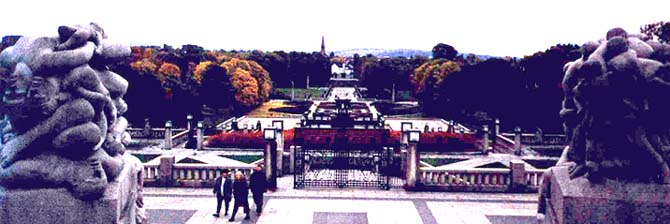
The trip to Norway was exhausting, in a way that only negotiating a series of airports with all of two people's carry on and a wheelchair can be. This even with Hans and Franz appearing at every stop to carry Mom on and off the plane. Will say that coming into Oslo after over a week in Finland and seeing Norwegian, which is at least vaguely related to a language I know, felt like coming home. Finnish, on the other hand, is related to almost nothing. Or more precisely, to Hungarian. In fact, even when Finnish was related to English I didn't always notice. The Finnish word for pharmacy is Apteeki, but it was not until I saw the Norwegian Apotek that I realized that they both were related to apothecary.
My time in Norway was so truncated by the stay in Finland that I feel like I can only talk about it in comparison to Finland. The first change was that in Norway, Ann was replaced by my sister Diane, who took her role as replacement very seriously and immediately started buying chocolate. In fact, the first chocolate she bought had cognac in it - enough to catch a buzz if you ate a few. Also in Norway, Hans and Franz were replaced by my father and brother who had to carry Mom from place to place all of the times that we had no wheelchair, and some of the time that we did, since the path up to the cottage was too steep to roll in any meaningful way.
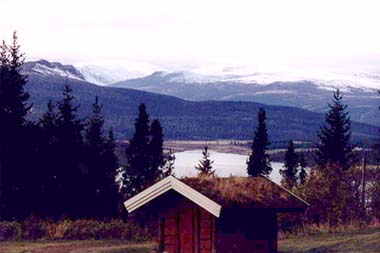 Finland was unquestionably beautiful, but Norway was breathtaking.
Snow-capped mountains were visible from our cabin. The area around the
cabin was loaded with even more hiking trails than in Finland, and they
went through beautiful territory, with lakes and streams, all covered with
frost on the day that I hiked them. The frost, of course, was a product
of the fact that Norway was colder than Finland, despite the fact that
there were more leaves left on the trees than there were in Finland by the
time I left. In fact, we were told that they usually have 50 cm. of snow
by that time of year, one thing that made me temporarily happy about
global warming. One day we set out in our relatively small rental
Mercedes to see the fjords. This involved fourteen hours round trip with
my father, my sister and I wedged so tight in the back seat that I thought
our hips would fuse. Fortunately, we stopped and got out a lot, and the
scenery was so amazing that we were able to overlook any discomfort for
the benefit of seeing more of it. The exception to this was Strun. In
Strun, it was foggy, and I had the feeling that it was like that a lot.
The fog around Strun almost convinced us to turn back but we decided to go
on a bit and see if it cleared. Good thing that we did - the fog near
Strun was the only fog that we saw that day.
Finland was unquestionably beautiful, but Norway was breathtaking.
Snow-capped mountains were visible from our cabin. The area around the
cabin was loaded with even more hiking trails than in Finland, and they
went through beautiful territory, with lakes and streams, all covered with
frost on the day that I hiked them. The frost, of course, was a product
of the fact that Norway was colder than Finland, despite the fact that
there were more leaves left on the trees than there were in Finland by the
time I left. In fact, we were told that they usually have 50 cm. of snow
by that time of year, one thing that made me temporarily happy about
global warming. One day we set out in our relatively small rental
Mercedes to see the fjords. This involved fourteen hours round trip with
my father, my sister and I wedged so tight in the back seat that I thought
our hips would fuse. Fortunately, we stopped and got out a lot, and the
scenery was so amazing that we were able to overlook any discomfort for
the benefit of seeing more of it. The exception to this was Strun. In
Strun, it was foggy, and I had the feeling that it was like that a lot.
The fog around Strun almost convinced us to turn back but we decided to go
on a bit and see if it cleared. Good thing that we did - the fog near
Strun was the only fog that we saw that day.
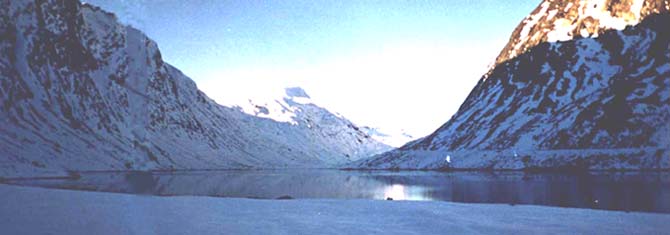
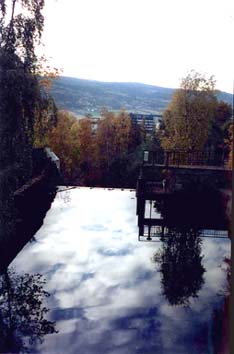
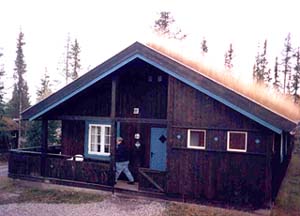 The nearest
town of any substance, Lillehammer, was smaller than Savonlinna, but had
more - a better art museum, a shopping district and so on. The cottage,
which came to be called the "cabbage" due to someone's mixing of cottage
and cabin, was smaller and cozier than the one in Finland, and had much
nicer beds. It also had a full head of hair, as it, like many buildings
in Norway, had grass growing on the roof for extra insulation. TV in
Norway, as in Finland, was largely in English with subtitles , but there
was much more available. We even watched South Park one night. Also
watched a movie, which we determined, after a period of puzzlement, was
running with subtitles that belonged to something else. Must have been
really fun for the folks who needed the subtitles.
The nearest
town of any substance, Lillehammer, was smaller than Savonlinna, but had
more - a better art museum, a shopping district and so on. The cottage,
which came to be called the "cabbage" due to someone's mixing of cottage
and cabin, was smaller and cozier than the one in Finland, and had much
nicer beds. It also had a full head of hair, as it, like many buildings
in Norway, had grass growing on the roof for extra insulation. TV in
Norway, as in Finland, was largely in English with subtitles , but there
was much more available. We even watched South Park one night. Also
watched a movie, which we determined, after a period of puzzlement, was
running with subtitles that belonged to something else. Must have been
really fun for the folks who needed the subtitles.
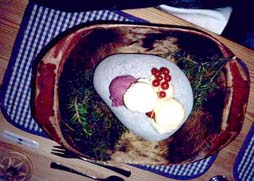 The
food that I had in Norway was mostly part of the cheese and crackers at
home variety, but we did eat in one great restaurant in Lom on the way
back from the fjords. It was possibly one of the most expensive
restaurants I ever set foot in (and I have expensive taste) but the food
was well worth it. I had a sea devil appetizer. (I don't know what a sea
devil is, but if you get a chance, you really ought to eat one). The
reindeer that I had for my entree was the most tender that we had
anywhere, and the ice cream that we had for dessert was served on a rock
that had been frozen and kept the ice cream cold.
The
food that I had in Norway was mostly part of the cheese and crackers at
home variety, but we did eat in one great restaurant in Lom on the way
back from the fjords. It was possibly one of the most expensive
restaurants I ever set foot in (and I have expensive taste) but the food
was well worth it. I had a sea devil appetizer. (I don't know what a sea
devil is, but if you get a chance, you really ought to eat one). The
reindeer that I had for my entree was the most tender that we had
anywhere, and the ice cream that we had for dessert was served on a rock
that had been frozen and kept the ice cream cold.
As in Finland, I did a survey of Norwegian beers, and with about the same results. In addition, I accidentally bought one that was "alkohol fritt," which really does not improve the taste. Worse yet is the national drink of alcoholics, aquavit. It is supposedly made of potatoes and caraway seeds, but the taste invokes blindness and death. We actually bought some, and I suspect that we will own it for a very long time.
Norway was more expensive than Finland. Apparently their economy is rolling and people can afford the prices that they charge, but yikes. One of the products of this is that when we went down to Oslo and got hotel rooms for the night, we got the smallest rooms that we had ever seen. In fact, when I show people the pictures, they always ask if we are on a train. That is what you get for $85 a night in Oslo. But it was clean, and in the long run, it was probably worth it for the humor.
The ride down to Oslo was humorous in itself. Now not only were we wedged hip to hip across the back seat, but half of our luggage was across our laps. It was a long three hours down to town, and a longer hour while we drove around Oslo looking for our destination: Vigelund Park. If you have never been to Oslo, I can only tell you that its street layout was apparently designed by a madman. It makes driving in Washington DC a picnic in comparison. Anyway, we eventually found Vigeland Park, which I had been commanded to see by friends of mine who had been to Norway years before. They were right. If you are ever in Norway, you must go see this park. It is full of the most amazing statues. Hundreds of them. It is also wheelchair accessible, if you happen to have a wheelchair. But we did not. While the resort had found us one for the time we were at the cabbage, we were not able to bring it to Oslo. There were none that we could find for rent either. In fact, while the Scandinavian countries are apparently among the more accessible in Europe, they still have a long way to go. The ramp into the most expensive restaurant I have ever been to led to a locked door. The motel that told us that the only barrier was two steps up into the room forgot about the forty-yard walk that was involved to get to those steps if you didn't just haul off and drive on their grass like the Americans that we are. Parks and restaurants did not supply wheelchairs, and rentals were virtually nonexistent. Even the ski resort did not have one. And where in the world is one more likely to start needing one?